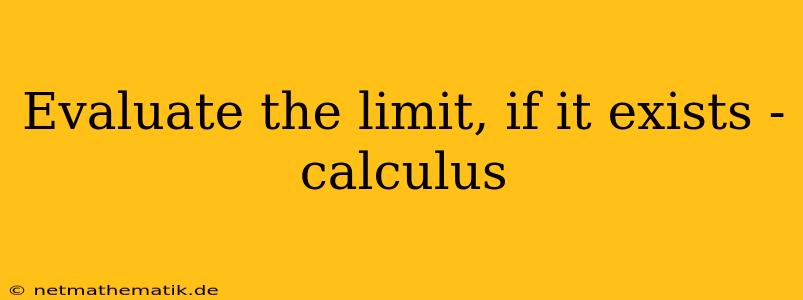The concept of limits is fundamental to calculus, providing the foundation for understanding continuity, derivatives, and integrals. A limit describes the behavior of a function as its input approaches a particular value. Evaluating limits often involves careful analysis and manipulation of algebraic expressions, and the application of various limit laws. This article will delve into the process of evaluating limits, exploring different techniques and providing examples to illustrate the concepts.
Understanding Limits
Before embarking on the evaluation of limits, let's establish a clear understanding of the concept itself. In simple terms, a limit of a function f(x) as x approaches a value 'a' is the value that the function 'approaches' as x gets closer and closer to 'a'. It is important to note that the function may or may not be defined at 'a' itself.
Formal Definition:
Mathematically, we can express the limit as follows:
The limit of f(x) as x approaches 'a' is equal to 'L', denoted as:
lim (x → a) f(x) = L
This means that for every ε > 0 (an arbitrarily small positive number), there exists a δ > 0 (another positive number) such that if 0 < |x - a| < δ, then |f(x) - L| < ε.
In essence, the definition states that as x gets arbitrarily close to 'a', the function f(x) gets arbitrarily close to 'L'.
Evaluating Limits: Techniques and Examples
Evaluating limits involves analyzing the function's behavior near the point of interest. Here are some common techniques used to determine the limit of a function:
1. Direct Substitution
This is the simplest approach and often works when the function is continuous at the point 'a'. If f(x) is continuous at x = a, then:
lim (x → a) f(x) = f(a)
Example:
Find the limit of f(x) = x^2 + 2x as x approaches 3.
lim (x → 3) (x^2 + 2x) = (3^2 + 2 * 3) = 15
2. Factorization and Simplification
When direct substitution leads to an indeterminate form (e.g., 0/0), factorization and simplification can often help determine the limit.
Example:
Find the limit of f(x) = (x^2 - 4)/(x - 2) as x approaches 2.
Direct substitution yields 0/0. We can factor the numerator:
lim (x → 2) (x^2 - 4)/(x - 2) = lim (x → 2) [(x + 2)(x - 2)] / (x - 2)
Canceling the (x - 2) terms, we get:
lim (x → 2) (x + 2) = 4
3. Rationalization
Rationalization can be used to eliminate radicals from the denominator or numerator, simplifying the expression and making it easier to evaluate the limit.
Example:
Find the limit of f(x) = (√(x + 1) - 1) / x as x approaches 0.
Direct substitution leads to 0/0. We can rationalize the numerator:
lim (x → 0) (√(x + 1) - 1) / x = lim (x → 0) [(√(x + 1) - 1) / x] * [(√(x + 1) + 1) / (√(x + 1) + 1)]
Simplifying the expression:
lim (x → 0) (x + 1 - 1) / [x(√(x + 1) + 1)] = lim (x → 0) 1 / (√(x + 1) + 1)
Now, substituting x = 0, we get:
1 / (√(0 + 1) + 1) = 1 / 2
4. L'Hopital's Rule
This rule applies when we have indeterminate forms like 0/0 or ∞/∞. It states that if the limit of f(x)/g(x) as x approaches 'a' is an indeterminate form, then:
lim (x → a) f(x)/g(x) = lim (x → a) f'(x)/g'(x)
Example:
Find the limit of f(x) = (sin(x))/x as x approaches 0.
Direct substitution yields 0/0. Applying L'Hopital's rule:
lim (x → 0) (sin(x))/x = lim (x → 0) cos(x) / 1 = cos(0) = 1
5. Squeeze Theorem
This theorem helps determine the limit of a function by comparing it to two other functions whose limits are known. If f(x) ≤ g(x) ≤ h(x) for all x in an interval around 'a', and lim (x → a) f(x) = lim (x → a) h(x) = L, then lim (x → a) g(x) = L.
Example:
Find the limit of f(x) = x^2 * sin(1/x) as x approaches 0.
We know -1 ≤ sin(1/x) ≤ 1 for all x. Multiplying all terms by x^2 (which is non-negative):
-x^2 ≤ x^2 * sin(1/x) ≤ x^2
Since lim (x → 0) -x^2 = lim (x → 0) x^2 = 0, by the squeeze theorem, lim (x → 0) x^2 * sin(1/x) = 0.
Conclusion
Evaluating limits is an essential skill in calculus, allowing us to understand the behavior of functions near specific points. By mastering the techniques outlined in this article – direct substitution, factorization, rationalization, L'Hopital's rule, and the squeeze theorem – you can successfully evaluate the limit of a wide range of functions, gaining deeper insights into their properties and applications in various mathematical and scientific fields.
